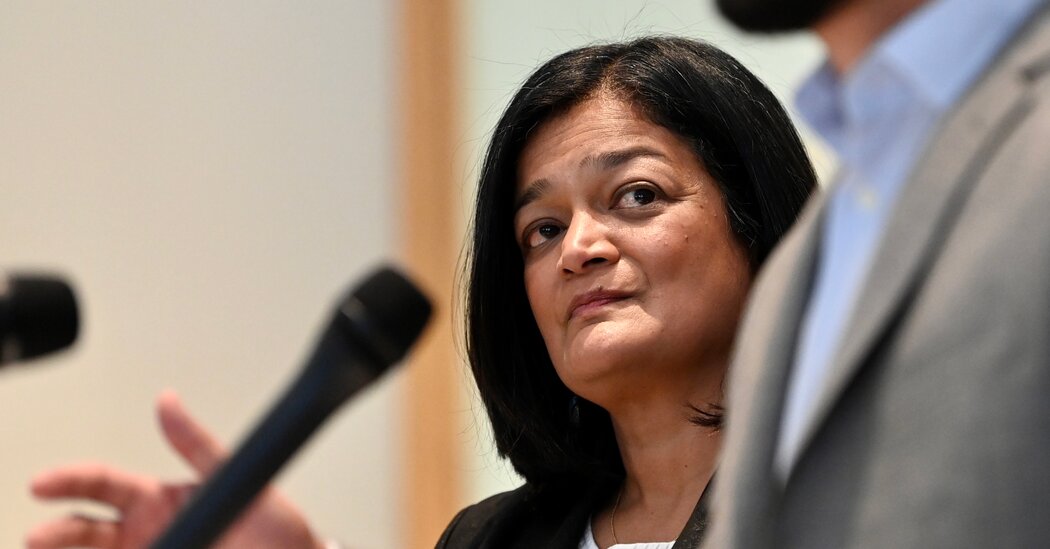Trump Plans to Expand Presidential Power Over Agencies in 2025
Donald J. Trump and his allies are planning a sweeping expansion of presidential power over the machinery of government if voters return him to the White House in 2025, reshaping the structure of the executive branch to concentrate far greater authority directly in his hands.
Their plans to centralize more power in the Oval Office stretch far beyond the former president’s recent remarks that he would order a criminal investigation into his political rival, President Biden, signaling his intent to end the post-Watergate norm of Justice Department independence from White House political control.
Mr. Trump and his associates have a broader goal: to alter the balance of power by increasing the president’s authority over every part of the federal government that now operates, by either law or tradition, with any measure of independence from political interference by the White House, according to a review of his campaign policy proposals and interviews with people close to him.
Mr. Trump intends to bring independent agencies — like the Federal Communications Commission, which makes and enforces rules for television and internet companies, and the Federal Trade Commission, which enforces various antitrust and other consumer protection rules against businesses — under direct presidential control.
He wants to revive the practice of “impounding” funds, refusing to spend money Congress has appropriated for programs a president doesn’t like — a tactic that lawmakers banned under President Richard Nixon.
He intends to strip employment protections from tens of thousands of career civil servants, making it easier to replace them if they are deemed obstacles to his agenda. And he plans to scour the intelligence agencies, the State Department and the defense bureaucracies to remove officials he has vilified as “the sick political class that hates our country.”
“The president’s plan should be to fundamentally reorient the federal government in a way that hasn’t been done since F.D.R.’s New Deal,” said John McEntee, a former White House personnel chief who began Mr. Trump’s systematic attempt to sweep out officials deemed to be disloyal in 2020 and who is now involved in mapping out the new approach.
“Our current executive branch,” Mr. McEntee added, “was conceived of by liberals for the purpose of promulgating liberal policies. There is no way to make the existing structure function in a conservative manner. It’s not enough to get the personnel right. What’s necessary is a complete system overhaul.”
Mr. Trump and his advisers are making no secret of their intentions — proclaiming them in rallies and on his campaign website, describing them in white papers and openly discussing them.
“What we’re trying to do is identify the pockets of independence and seize them,” said Russell T. Vought, who ran the Office of Management and Budget in the Trump White House and now runs a policy organization, the Center for Renewing America.
The strategy in talking openly about such “paradigm-shifting ideas” before the election, Mr. Vought said, is to “plant a flag” — both to shift the debate and to later be able to claim a mandate. He said he was delighted to see few of Mr. Trump’s Republican primary rivals defend the norm of Justice Department independence after the former president openly attacked it.
Steven Cheung, a spokesman for Mr. Trump’s campaign, said in a statement that the former president has “laid out a bold and transparent agenda for his second term, something no other candidate has done.” He added, “Voters will know exactly how President Trump will supercharge the economy, bring down inflation, secure the border, protect communities and eradicate the deep state that works against Americans once and for all.”
The two driving forces of this effort to reshape the executive branch are Mr. Trump’s own campaign policy shop and a well-funded network of conservative groups, many of which are populated by former senior Trump administration officials who would most likely play key roles in any second term.
Mr. Vought and Mr. McEntee are involved in Project 2025, a $22 million presidential transition operation that is preparing policies, personnel lists and transition plans to recommend to any Republican who may win the 2024 election. The transition project, the scale of which is unprecedented in conservative politics, is led by the Heritage Foundation, a think tank that has shaped the personnel and policies of Republican administrations since the Reagan presidency.
That work at Heritage dovetails with plans on the Trump campaign website to expand presidential power that were drafted primarily by two of Mr. Trump’s advisers, Vincent Haley and Ross Worthington, with input from other advisers, including Stephen Miller, the architect of the former president’s hard-line immigration agenda.
Some elements of the plans had been floated when Mr. Trump was in office but were impeded by internal concerns that they would be unworkable and could lead to setbacks. And for some veterans of Mr. Trump’s turbulent White House who came to question his fitness for leadership, the prospect of removing guardrails and centralizing even greater power over government directly in his hands sounded like a recipe for mayhem.
“It would be chaotic,” said John F. Kelly, Mr. Trump’s second White House chief of staff. “It just simply would be chaotic, because he’d continually be trying to exceed his authority but the sycophants would go along with it. It would be a nonstop gunfight with the Congress and the courts.”
The agenda being pursued has deep roots in the decades-long effort by conservative legal thinkers to undercut what has become known as the administrative state — agencies that enact regulations aimed at keeping the air and water clean and food, drugs and consumer products safe, but that cut into business profits.
Its legal underpinning is a maximalist version of the so-called unitary executive theory.
The legal theory rejects the idea that the government is composed of three separate branches with overlapping powers to check and balance each other. Instead, the theory’s adherents argue that Article 2 of the Constitution gives the president complete control of the executive branch, so Congress cannot empower agency heads to make decisions or restrict the president’s ability to fire them. Reagan administration lawyers developed the theory as they sought to advance a deregulatory agenda.
“The notion of independent federal agencies or federal employees who don’t answer to the president violates the very foundation of our democratic republic,” said Kevin D. Roberts, the president of the Heritage Foundation, adding that the contributors to Project 2025 are committed to “dismantling this rogue administrative state.”
Personal power has always been a driving force for Mr. Trump. He often gestures toward it in a more simplistic manner, such as in 2019, when he declared to a cheering crowd, “I have an Article 2, where I have the right to do whatever I want as president.”
Mr. Trump made the remark in reference to his claimed ability to directly fire Robert S. Mueller III, the special counsel in the Russia inquiry, which primed his hostility toward law enforcement and intelligence agencies. He also tried to get a subordinate to have Mr. Mueller ousted, but was defied.
Early in Mr. Trump’s presidency, his chief strategist, Stephen K. Bannon, promised a “deconstruction of the administrative state.” But Mr. Trump installed people in other key roles who ended up telling him that more radical ideas were unworkable or illegal. In the final year of his presidency, he told aides he was fed up with being constrained by subordinates.
Now, Mr. Trump is laying out a far more expansive vision of power in any second term. And, in contrast with his disorganized transition after his surprise 2016 victory, he now benefits from a well-funded policymaking infrastructure, led by former officials who did not break with him after his attempts to overturn the 2020 election and the Jan. 6, 2021, attack on the Capitol.
One idea the people around Mr. Trump have developed centers on bringing independent agencies under his thumb.
Congress created these specialized technocratic agencies inside the executive branch and delegated to them some of its power to make rules for society. But it did so on the condition that it was not simply handing off that power to presidents to wield like kings — putting commissioners atop them whom presidents appoint but generally cannot fire before their terms end, while using its control of their budgets to keep them partly accountable to lawmakers as well. (Agency actions are also subject to court review.)
Presidents of both parties have chafed at the agencies’ independence. President Franklin D. Roosevelt, whose New Deal created many of them, endorsed a proposal in 1937 to fold them all into cabinet departments under his control, but Congress did not enact it.
Later presidents sought to impose greater control over nonindependent agencies Congress created, like the Environmental Protection Agency, which is run by an administrator whom a president can remove at will. For example, President Ronald Reagan issued executive orders requiring nonindependent agencies to submit proposed regulations to the White House for review. But overall, presidents have largely left the independent agencies alone.
Mr. Trump’s allies are preparing to change that, drafting an executive order requiring independent agencies to submit actions to the White House for review. Mr. Trump endorsed the idea on his campaign website, vowing to bring them “under presidential authority.”
Such an order was drafted in Mr. Trump’s first term — and blessed by the Justice Department — but never issued amid internal concerns. Some of the concerns were over how to carry out reviews for agencies that are headed by multiple commissioners and subject to administrative procedures and open-meetings laws, as well as over how the market would react if the order chipped away at the Federal Reserve’s independence, people familiar with the matter said.
The Federal Reserve was ultimately exempted in the draft executive order, but Mr. Trump did not sign it before his presidency ended. If Mr. Trump and his allies get another shot at power, the independence of the Federal Reserve — an institution Mr. Trump publicly railed at as president — could be up for debate. Notably, the Trump campaign website’s discussion of bringing independent agencies under presidential control is silent on whether that includes the Fed.
Asked whether presidents should be able to order interest rates lowered before elections, even if experts think that would hurt the long-term health of the economy, Mr. Vought said that would have to be worked out with Congress. But “at the bare minimum,” he said, the Federal Reserve’s regulatory functions should be subject to White House review.
“It’s very hard to square the Fed’s independence with the Constitution,” Mr. Vought said.
Other former Trump administration officials involved in the planning said there would also probably be a legal challenge to the limits on a president’s power to fire heads of independent agencies. Mr. Trump could remove an agency head, teeing up the question for the Supreme Court.
The Supreme Court in 1935 and 1988 upheld the power of Congress to shield some executive branch officials from being fired without cause. But after justices appointed by Republicans since Reagan took control, it has started to erode those precedents.
Peter L. Strauss, professor emeritus of law at Columbia University and a critic of the strong version of the unitary executive theory, argued that it is constitutional and desirable for Congress, in creating and empowering an agency to perform some task, to also include some checks on the president’s control over officials “because we don’t want autocracy” and to prevent abuses.
“The regrettable fact is that the judiciary at the moment seems inclined to recognize that the president does have this kind of authority,” he said. “They are clawing away agency independence in ways that I find quite unfortunate and disrespectful of congressional choice.”
Mr. Trump has also vowed to impound funds, or refuse to spend money appropriated by Congress. After Nixon used the practice to aggressively block agency spending he was opposed to, on water pollution control, housing construction and other issues, Congress banned the tactic.
On his campaign website, Mr. Trump declared that presidents have a constitutional right to impound funds and said he would restore the practice — though he acknowledged it could result in a legal battle.
Mr. Trump and his allies also want to transform the civil service — government employees who are supposed to be nonpartisan professionals and experts with protections against being fired for political reasons.
The former president views the civil service as a den of “deep staters” who were trying to thwart him at every turn, including by raising legal or pragmatic objections to his immigration policies, among many other examples. Toward the end of his term, his aides drafted an executive order, “Creating Schedule F in the Excepted Service,” that removed employment protections from career officials whose jobs were deemed linked to policymaking.
Mr. Trump signed the order, which became known as Schedule F, near the end of his presidency, but President Biden rescinded it. Mr. Trump has vowed to immediately reinstitute it in a second term.
Critics say he could use it for a partisan purge. But James Sherk, a former Trump administration official who came up with the idea and now works at the America First Policy Institute — a think tank stocked heavily with former Trump officials — argued it would only be used against poor performers and people who actively impeded the elected president’s agenda.
“Schedule F expressly forbids hiring or firing based on political loyalty,” Mr. Sherk said. “Schedule F employees would keep their jobs if they served effectively and impartially.”
Mr. Trump himself has characterized his intentions rather differently — promising on his campaign website to “find and remove the radicals who have infiltrated the federal Department of Education” and listing a litany of targets at a rally last month.
“We will demolish the deep state,” Mr. Trump said at the rally in Michigan. “We will expel the warmongers from our government. We will drive out the globalists. We will cast out the communists, Marxists and fascists. And we will throw off the sick political class that hates our country.”


